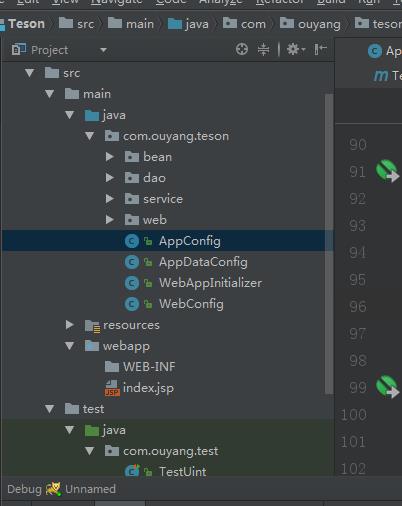spring4+srpingmvc+mybatis基本框架(app框架搭建一)
Posted 北冥大帝
tags:
篇首语:本文由小常识网(cha138.com)小编为大家整理,主要介绍了spring4+srpingmvc+mybatis基本框架(app框架搭建一)相关的知识,希望对你有一定的参考价值。
前言:
随着spring 越来越强大,用spring4来搭建框架也是很快速,问题是你是对spring了解有多深入。如果你是新手,那么在搭建的过程中可以遇到各种各样奇葩的问题。
SSM框架的搭建是作为我搭建APP开发框架的基础。
我将会分以下几点:
1) 配置文件如何配置
2) 如何java配置启动servlet
3) 一些搭建过程中的坑
=============================================================================
配置文件如何配置
SSM框架的搭建配置方式有很多种,可具体分可以分为javaConfig配置,xml配置,或者xml文件与javaConf混合配置。其实用那种都行了,我个人搭建还是偏xml配置,不过现在的javaConfig也很成熟,也可以考虑,就是有一些坑,后面会讲到的;混合配置,用的情况也是蛮多的,分享中会涉及一点。
接下来,我主要是以java配置类做的配置:

这是项目的结构 com.ouyang.teson目录下直接放置配置类:
1)AppConfig.java
package com.ouyang.teson; import org.mybatis.spring.mapper.MapperScannerConfigurer; import org.springframework.context.annotation.*; import org.springframework.transaction.annotation.EnableTransactionManagement; import org.springframework.web.servlet.config.annotation.EnableWebMvc; import org.springframework.web.servlet.mvc.Controller; /** * Created by ThinkPad on 2017/6/15. */ @Configuration @EnableAspectJAutoProxy @EnableTransactionManagement @ComponentScan(basePackages = {"com.ouyang.teson"}, excludeFilters={@ComponentScan.Filter(type=FilterType.ANNOTATION,value=EnableWebMvc.class)} ) @Import(AppDataConfig.class) //@PropertySource({"classpath:jdbc.properties"}) //@ImportSource("XXXX.xml") /*@Configuration,用于表示这个类是一个配置类,用于配置Spring的相关信息 @EnableAspectJAutoProxy,启用切面自动代理,用于AOP @EnableTransactionManagement,启用注解事务,即可以使用@Transactional注解来控制事务 @ComponentScan,组件扫描,在basePackages指定的目录下扫描被@Controller、@Service、@Component等注解注册的组件 @Import,引入指定的配置类,我们引入了Spring容器配置类和数据源事务配置类 @PropertySource,加载指定的配置文件,配置文件内容会加载入Environment中等待调用*/ public class AppConfig { @Bean public MapperScannerConfigurer mapperScannerConfigurer() { MapperScannerConfigurer mapperScannerConfigurer = new MapperScannerConfigurer(); // 跟@MapperScan(basePackages = { "com.ouyang.teson.dao" }) 等同 //如果通过web.xml 加载servlet的话,可能找不到映射对象 建议用注解 mapperScannerConfigurer.setBasePackage("com.ouyang.teson.dao"); mapperScannerConfigurer.setSqlSessionFactoryBeanName("sqlSessionFactory"); return mapperScannerConfigurer; } }
2) AppDataConfig.java 是导入的配置
package com.ouyang.teson; import com.alibaba.druid.pool.DruidDataSource; import com.ouyang.teson.bean.TestBean; import org.apache.ibatis.session.SqlSessionFactory; import org.mybatis.spring.SqlSessionFactoryBean; import org.mybatis.spring.SqlSessionTemplate; import org.mybatis.spring.annotation.MapperScan; import org.mybatis.spring.mapper.MapperScannerConfigurer; import org.springframework.beans.factory.annotation.Autowired; import org.springframework.context.annotation.*; import org.springframework.core.env.Environment; import org.springframework.core.io.support.PathMatchingResourcePatternResolver; import org.springframework.jdbc.datasource.DataSourceTransactionManager; import org.springframework.transaction.annotation.EnableTransactionManagement; import javax.sql.DataSource; import java.io.IOException; /** * Created by ThinkPad on 2017/6/15. */ @EnableAspectJAutoProxy @EnableTransactionManagement @PropertySource({"classpath:jdbc.properties"}) //@MapperScan(value={"/com/ouyang/teson/dao/*.xml"},basePackages = {"com.ouyang.teson.dao"}) public class AppDataConfig { @Autowired private Environment env; //设置阿里druid数据源 @Bean(name="dataSource") public DataSource getDataSource() { DruidDataSource druidDataSource = new DruidDataSource(); System.out.println("=============env============"+env.getProperty("jdbc.driverClassName")); druidDataSource.setDriverClassName(env.getProperty("jdbc.driverClassName")); druidDataSource.setUsername(env.getProperty("jdbc.username")); druidDataSource.setPassword(env.getProperty("jdbc.password")); druidDataSource.setUrl(env.getProperty("jdbc.url")); //连接超时时间 druidDataSource.setMaxWait(10000); //最大存活时间 //druidDataSource.setMaxActive(10000); // 配置间隔多久才进行一次检测,检测需要关闭的空闲连接,单位是毫秒 druidDataSource.setTimeBetweenEvictionRunsMillis(60000); //连接池中的最小生存时间 druidDataSource.setMinEvictableIdleTimeMillis(300000); //这里建议配置为TRUE,防止取到的连接不可用 druidDataSource.setTestOnBorrow(true); druidDataSource.setTestOnReturn(false); //自动提交 druidDataSource.setDefaultAutoCommit(true); druidDataSource.setPoolPreparedStatements(true); druidDataSource.setMaxPoolPreparedStatementPerConnectionSize(20); return druidDataSource; } // 配置SqlSessionFactory对象 public SqlSessionFactoryBean getSqSesionFactorys() throws IOException { SqlSessionFactoryBean sqlSessionFactoryBean =new SqlSessionFactoryBean(); sqlSessionFactoryBean.setDataSource(getDataSource()); // sqlSessionFactoryBean.setConfigLocation(new ClassPathResource("mybatis-config.xml")); // 这里可以通过mybatis-config.xml 来设置 typeAliasPackage和mapper。 //这个setMapperLocations 必须把mapper文件放resources里面 不然获取文件 //扫描mybatis配置文件的 PathMatchingResourcePatternResolver resolver = new PathMatchingResourcePatternResolver(); sqlSessionFactoryBean.setMapperLocations(resolver.getResources("classpath:mapper/*.xml")); /* Resource[] mapperLocations = new Resource[] { new ClassPathResource("/com/ouyang/teson/mapper*//**//*.xml") }; sqlSessionFactoryBean.setMapperLocations(mapperLocations);*//* *//* Resource resource =new ClassPathResource("mybatis.xml"); sqlSessionFactoryBean.setConfigLocation(resource);*/ //设置映射的bean类 sqlSessionFactoryBean.setTypeAliasesPackage("com.ouyang.teson.bean"); return sqlSessionFactoryBean; } @Bean(name = "sqlSessionFactory") public SqlSessionFactory sqlSessionFactory() throws Exception { SqlSessionFactoryBean factoryBean = getSqSesionFactorys(); SqlSessionFactory sqlSessionFactory = factoryBean.getObject(); sqlSessionFactory.getConfiguration().setMapUnderscoreToCamelCase(true);// 开启驼峰映射 sqlSessionFactory.getConfiguration().setCacheEnabled(true); //sqlSessionFactory.getConfiguration().setLazyLoadingEnabled(true); sqlSessionFactory.getConfiguration().setAggressiveLazyLoading(false); return sqlSessionFactory; } @Bean(name = "transactionManager") public DataSourceTransactionManager dataSourceTransactionManager() { DataSourceTransactionManager dataSourceTransactionManager = new DataSourceTransactionManager(); dataSourceTransactionManager.setDataSource(this.getDataSource()); return dataSourceTransactionManager; } @Bean @Scope("prototype") public SqlSessionTemplate sqlSessionTemplate() throws Exception { SqlSessionTemplate template =new SqlSessionTemplate(sqlSessionFactory()); return template; } }
3)webConfig.java
package com.ouyang.teson; import org.slf4j.Logger; import org.slf4j.LoggerFactory; import org.springframework.context.annotation.Bean; import org.springframework.context.annotation.ComponentScan; import org.springframework.context.annotation.Configuration; import org.springframework.context.annotation.FilterType; import org.springframework.web.servlet.ViewResolver; import org.springframework.web.servlet.config.annotation.EnableWebMvc; import org.springframework.web.servlet.config.annotation.ResourceHandlerRegistry; import org.springframework.web.servlet.config.annotation.WebMvcConfigurerAdapter; import org.springframework.web.servlet.mvc.Controller; import org.springframework.web.servlet.view.InternalResourceViewResolver; /** * Created by ThinkPad on 2017/6/15. */ @Configuration @EnableWebMvc @ComponentScan(basePackages = {"com.ouyang.teson"},useDefaultFilters = true) public class WebConfig extends WebMvcConfigurerAdapter{ private final static Logger logger = LoggerFactory.getLogger(WebConfig.class); public ViewResolver viewResolver() { InternalResourceViewResolver viewResolver = new InternalResourceViewResolver(); viewResolver.setPrefix("/WEB-INF/views/jsp/function/"); viewResolver.setSuffix(".jsp"); return viewResolver; } //静态文件 @Override public void addResourceHandlers(ResourceHandlerRegistry registry) { logger.info("addResourceHandlers"); registry.addResourceHandler("/static/**").addResourceLocations("/WEB-INF/static/"); } }
SpringMvc也设置了@ComponentScan,也会去扫相应的包,useDefaultFilters = true 会自动过滤 @Component@Repository, @Service, or @Controller 一些重复的;
4) resources 配置目录下 主要是两个文件:1,jdbc.properties ;2,logback.xml
以下是logback.xml,还稍微比较乱,拿其他项目的配置,顺便改了一下
<?xml version="1.0" encoding="UTF-8"?> <configuration> <property name="LOG_HOME" value="D:/logs2/" /> <appender name="STDOUT" class="ch.qos.logback.core.ConsoleAppender"> <encoder> <pattern>%d{yyyy-MM-dd HH:mm:ss.SSS} [%thread] %-5level [%logger{36}] - %msg%n </pattern> </encoder> </appender> <appender name="FILE" class="ch.qos.logback.core.rolling.RollingFileAppender"> <file>${LOG_HOME}/dts_rpc_main.log</file> <rollingPolicy class="ch.qos.logback.core.rolling.TimeBasedRollingPolicy"> <!-- rollover daily --> <fileNamePattern>${LOG_HOME}/logbak/dts_rpc_main-%d{yyyy-MM-dd}.%i.log.zip</fileNamePattern> <timeBasedFileNamingAndTriggeringPolicy class="ch.qos.logback.core.rolling.SizeAndTimeBasedFNATP"> <!-- or whenever the file size reaches 300MB --> <maxFileSize>1000MB</maxFileSize> </timeBasedFileNamingAndTriggeringPolicy> </rollingPolicy> <!-- 日志输出格式 --> <encoder> <pattern>%d{yyyy-MM-dd HH:mm:ss.SSS} [%thread] %-5level %logger{36} - %msg%n </pattern> </encoder> </appender> <logger name="com.ouyang.teson" level="INFO" additivity="false"> <appender-ref ref="FILE" /> </logger> <logger name="org.springframework" level="WARN" additivity="false"> <appender-ref ref="STDOUT" /> </logger> <logger name="org.springframework.boot" level="WARN" additivity="false"> <appender-ref ref="STDOUT" /> </logger> <logger name="org.mybatis" level="WARN" additivity="false"> <appender-ref ref="STDOUT" /> </logger> <logger name="org.apache" level="WARN" additivity="false"> <appender-ref ref="STDOUT" /> </logger> <logger name="com.ouyang" level="DEBUG" additivity="false"> <appender-ref ref="STDOUT" /> </logger> <logger name="com.alibaba" level="DEBUG" additivity="false"> <appender-ref ref="STDOUT" /> </logger> <root level="DEBUG"> <appender-ref ref="STDOUT" /> </root> </configuration>
5) pom.xml
导入的包,都是当下最新的包
<project xmlns="http://maven.apache.org/POM/4.0.0" xmlns:xsi="http://www.w3.org/2001/XMLSchema-instance" xsi:schemaLocation="http://maven.apache.org/POM/4.0.0 http://maven.apache.org/maven-v4_0_0.xsd"> <modelVersion>4.0.0</modelVersion> <groupId>com.ouyang</groupId> <artifactId>Teson</artifactId> <packaging>war</packaging> <version>1.0-SNAPSHOT</version> <name>Teson Maven Webapp</name> <url>http://maven.apache.org</url> <properties> <!-- spring版本号 --> <spring.version>4.3.9.RELEASE</spring.version> <!-- log4j日志文件管理包版本 --> <slf4j.version>1.6.6</slf4j.version> <log4j.version>1.2.12</log4j.version> <!-- mybatis版本号 --> <mybatis.version>3.4.4</mybatis.version> </properties> <dependencies> <dependency> <groupId>junit</groupId> <artifactId>junit</artifactId> <version>4.12</version> <scope>test</scope> </dependency> <!-- spring-core --> <dependency> <groupId>org.springframework</groupId> <artifactId>spring-core</artifactId> <version>${spring.version}</version> </dependency> <dependency> <groupId>org.springframework</groupId> <artifactId>spring-context</artifactId> <version>${spring.version}</version> </dependency> <dependency> <groupId>org.springframework</groupId> <artifactId>spring-test</artifactId> <version>${spring.version}</version> </dependency> <dependency> <groupId>org.springframework</groupId> <artifactId>spring-aop</artifactId> <version>${spring.version}</version> </dependency> <dependency> <groupId>org.springframework</groupId> <artifactId>spring-jdbc</artifactId> <version>${spring.version}</version> </dependency> <dependency> <groupId>org.springframework</groupId> <artifactId>spring-webmvc</artifactId> <version>${spring.version}</version> </dependency> <!-- AspectJ Runtime --> <dependency> <groupId>org.aspectj</groupId> <artifactId>aspectjrt</artifactId> <version>1.8.6</version> </dependency> <!-- AspectJ Weaver --> <dependency> <groupId>org.aspectj</groupId> <artifactId>aspectjweaver</artifactId> <version>1.8.6</version> </dependency> <!-- log 日志 --> <dependency> <groupId>org.slf4j</groupId> <artifactId>jcl-over-slf4j</artifactId> <version>1.7.21</version> </dependency> <dependency> <groupId>ch.qos.logback</groupId> <artifactId>logback-classic</artifactId> <version>1.1.7</version> </dependency> <!-- mybatis --> <dependency> <groupId>org.mybatis</groupId> <artifactId>mybatis</artifactId> <version>${mybatis.version}</version> </dependency> <dependency> <groupId>org.mybatis</groupId> <artifactId>mybatis-spring</artifactId> <version>1.3.1</version> </dependency> <!-- mysql驱动包 --> <dependency> <groupId>mysql</groupId> <artifactId>mysql-connector-java</artifactId> <version>5.1.29</version> </dependency> <!-- https://mvnrepository.com/artifact/com.alibaba/druid --> <dependency> <groupId>com.alibaba</groupId> <artifactId>druid</artifactId> <version>1.0.31</version> </dependency> <!-- https://mvnrepository.com/artifact/com.google.code.gson/gson --> <dependency> <groupId>com.google.code.gson</groupId> <artifactId>gson</artifactId> <version>2.8.0</version> </dependency> <dependency> <groupId>junit</groupId> <artifactId>junit</artifactId> <version>RELEASE</version> </dependency> <!-- https://mvnrepository.com/artifact/javax.servlet/javax.servlet-api --> <dependency> <groupId>javax.servlet</groupId> <artifactId>javax.servlet-api</artifactId> <version>3.1.0</version> <scope>provided</scope> </dependency> </dependencies> <build> <finalName>Teson</finalName> <!--<build> <finalName>app</finalName> </build>--> <resources> <resource> <directory>src/main/java</directory> <includes> <include>**/*.xml</include> </includes> <filtering>false</filtering> </resource> </resources> <plugins> <plugin> <groupId>org.apache.maven.plugins</groupId> <artifactId>maven-compiler-plugin</artifactId> <version>3.5.1</version> <configuration> <source>1.8</source> <target>1.8</target> <encoding>UTF-8</encoding> </configuration> </plugin> <!--- 为防止 没有web.xml 情况下打包报错 --> <plugin> <groupId>org.apache.maven.plugins</groupId> <artifactId>maven-war-plugin</artifactId> <version>2.2</version> <configuration> <failOnMissingWebXml>false</failOnMissingWebXml> </configuration> </plugin> </plugins> </build> </project>
基本的配置就这样,有基础基本都能看得懂
接下来,要说说怎么启动web服务器了
启动web服务
1)方法1
在servlet3.0之后,启动servlet,在spring里是可以直接通过java配置类进行加载servlet的。
springmvc 提供一个类AbstractAnnotationConfigDispatcherServletInitializer,该类创建了DispatcherServlet和ContextLoaderListener:getServletConfigClasses()返回的配置类定义了Spring MVC应用容器中的beans;getRootConfigClasses()返回的配置类定义了Spring应用根容器中的beans。
Spring MVC容器是根容器的子容器,子容器可以看到根容器中定义的beans,反之不行。
注意:通过AbstractAnnotationConfigDispatcherServletInitializer配置DispatcherServlet仅仅是传统的web.xml文件方式的另一个可选项。尽管你也可以使用AbstractAnnotationConfigDispatcherServletInitializer的一个子类引入web.xml文件来配置,但这没有必要。
可以参考文章:https://segmentfault.com/a/1190000004343063?_ea=575820
所以你只要自定一个类继承AbstractAnnotationConfigDispatcherServletInitializer ,你可以删掉web.xml了
webAppInitalzer.java
package com.ouyang.teson; import org.springframework.web.servlet.support.AbstractAnnotationConfigDispatcherServletInitializer; /** * Created by ThinkPad on 2017/6/15. */ public class WebAppInitializer extends AbstractAnnotationConfigDispatcherServletInitializer { @Override protected Class<?>[] getRootConfigClasses() { return new Class[] { AppConfig.class }; } @Override protected Class<?>[] getServletConfigClasses() { return new Class[] { WebConfig.class }; } /** * identifies one or more paths that DispatcherServlet will be mapped to.<br> * In this case, it’s mapped to /, indicating that it will be the application’s default servlet.<br> * It will handle all requests coming into the application. */ @Override protected String[] getServletMappings() { return new String[] { "/" }; } }
2) 方法2
你还是可以依然使用web.xml 来加载servlet,以下是web.xml的配置
<!DOCTYPE web-app PUBLIC "-//Sun Microsystems, Inc.//DTD Web Application 2.3//EN" "http://java.sun.com/dtd/web-app_2_3.dtd" > <web-app> <context-param> <param-name>contextClass</param-name> <param-value>org.springframework.web.context.support.AnnotationConfigWebApplicationContext</param-value> </context-param> <context-param> <param-name>contextClassLocation</param-name> <param-value>com.ouyang.teson.AppConfig</param-value> </context-param> <listener> <listener-class>org.springframework.web.context.ContextLoaderListener</listener-class> </listener> <servlet> <servlet-name>springServlet</servlet-name> <servlet-class>org.springframework.web.servlet.DispatcherServlet</servlet-class> <init-param> <param-name>contextClass</param-name> <param-value>org.springframework.web.context.support.AnnotationConfigWebApplicationContext</param-value> </init-param> <init-param> <param-name>contextConfigLocations</param-name> <param-value>com.ouyang.teson.WebConfig</param-value> </init-param> <load-on-startup>1</load-on-startup> </servlet> <servlet-mapping> <servlet-name>springServlet</servlet-name> <url-pattern>/</url-pattern> </servlet-mapping> <display-name>Archetype Created Web Application</display-name> </web-app>
一些坑的总结
1)@PropertiesSource 该注解主要是导入配置属性的,可是如果该配置类里面,如果有@bean的方法加载失败,则会直接报@PropertiesSource的属性找不到,而是定位到具体的@bean配置出现问题。
查看源码,确实很难debug代码到具体的问题,层次太深了。
2)同一个配置类,@bean的方法,在处理@bean时,是把配置加载到List集合,然后统一实例化,如果有@bean的方法是通过ContentServlet去获取bean的可能获取不到而直接报错。
ConfigurationClassParser.java 是直接加载配置类注解的主要逻辑处理,处理流程是先加载配置文件@PropertiesSource,然后处理 ComponentScans注解,加载文件,接着是处理@Import 和@importSource注解,调用processImports(configClass, sourceClass, getImports(sourceClass), true)进行处理,处理导入的配置类如果没有异常,就会把bean加载到serveltcontenx里,在主配置类就可以注入使用,如果注入不了,说明导入的配置类有问题,接着处理配置中@Bean的方法,接着processInterfaces(configClass, sourceClass)处理继承接口的默认方法。其实这个过程中,是有重复加载的,@bean的方法实例化的对象也是有重复的过程,具体怎么实现没有跟踪下去。 有时间可以自己去跟踪一下代码。
3) 还有一个坑,就是mybatis的配置,PathMatchingResourcePatternResolver resolver = new PathMatchingResourcePatternResolver();
sqlSessionFactoryBean.setMapperLocations(resolver.getResources("classpath:mapper/*.xml")); 这里配置到com.ouyang.teson.mapper 不起作用,原因是maven打包的时候不会把classpath下的xml打包进去,不过在resources下的配置文件是可以被打包进去的,所有必须把xml文件放到resources下面,才能在命名空间,映射到具体的sql。
建议:
1,配置的时候建议一步步来,不要一下配置得太多,而且一边配置,一边测试,那是最好的,避免配置太多无法一下子定位问题。
以上是关于spring4+srpingmvc+mybatis基本框架(app框架搭建一)的主要内容,如果未能解决你的问题,请参考以下文章
MyBatis学习总结——Mybatis3.x与Spring4.x整合
MyBatis学习总结——Mybatis3.x与Spring4.x整合
MyBatis学习总结——Mybatis3.x与Spring4.x整合